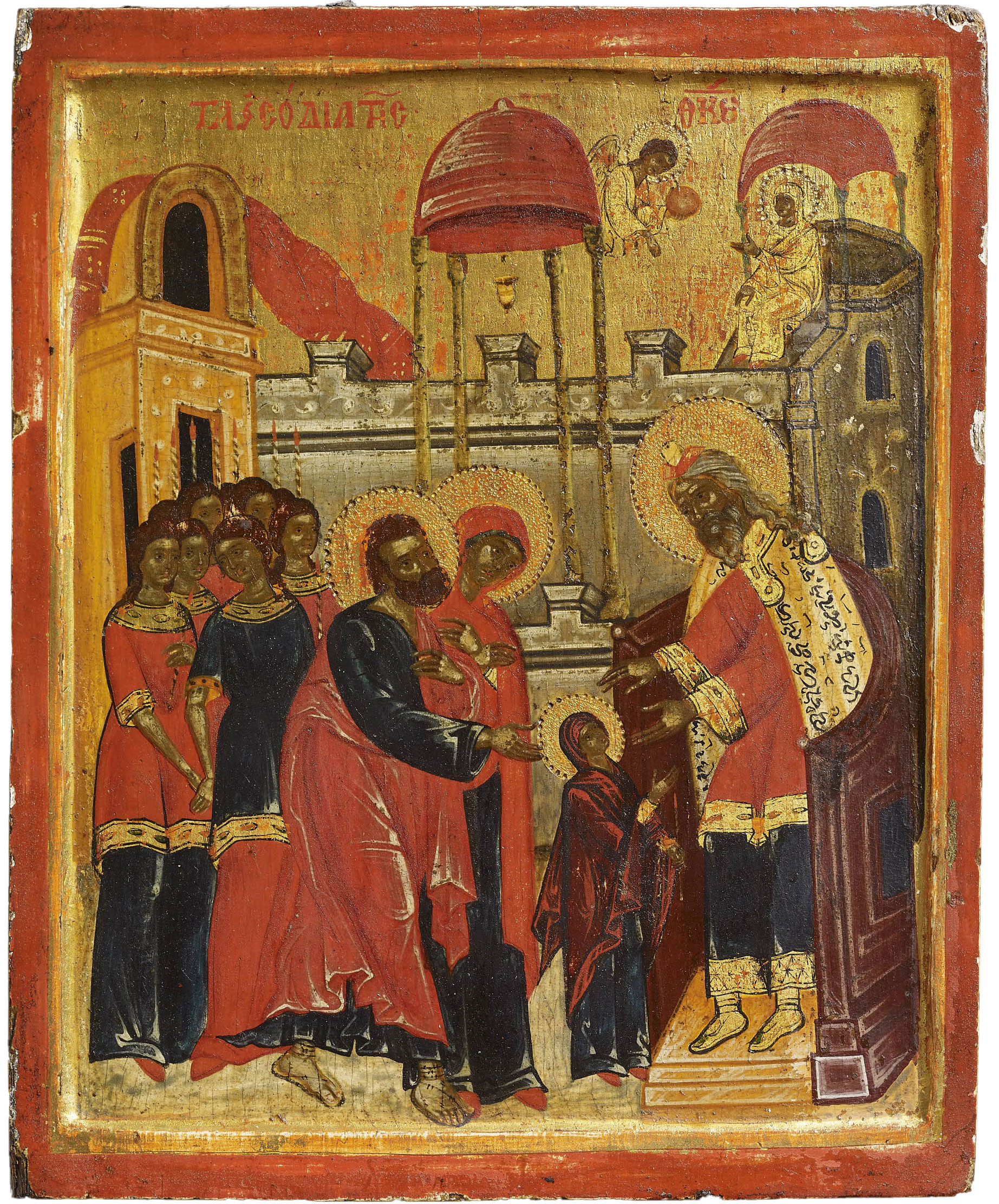The icon is painted in egg tempera with gold leaf on wood primed with gesso. It depicts two episodes from the early life of the Virgin: the Presentation in the Temple and (in the upper right) her nourishment by the angel, both deriving from the apocryphal Gospel, the Protoevangelion of James (7:1-3, 8:1-2). An inscription at the top of the icon in red capital letters identifies the scene as ΤΑ ΕΙCΟΔΙΑ ΤΗC Θ[ΕΟΤΟ]ΚΟΥ (‘The Entry of the Virgin’, or ‘the Presentation of the Virgin in the Temple’). The icon is framed by a raised integral red and gold border, while the reverse is painted dark brown.
The three-year-old Virgin with her parents Joachim and Anna is received in the Temple at Jerusalem by the high priest Zachariah. He reaches affectionately towards her, while Joachim encourages the child to move forward. The daughters of Zion are painted on the left of the scene holding lighted candles. The two front figures are looking at each other as if in conversation and unusually are depicted holding hands. All the girls are dressed in a similar way, with red and blue garments edged in gold. Of all the figures in the icon, Zachariah is depicted in the most impressive way; he is clad in a short red tunic over a longer one and has a mantle decorated with pseudo-Kufic letters (they imitate Arabic, but are meaningless).
Behind Zachariah a dark green building covered with a red canopy represents the Holy of Holies. In it the Virgin is seated in solitary confinement and receives a piece of bread from the angel of the Lord. In this second episode, the Virgin Mary is wearing gold garments; in her other portrayal on the icon, she is clad in the traditional blue tunic and red maphorion. This is an unusual feature, as the Virgin generally appears in the same garments in both scenes.
The composition follows a well-established Byzantine scheme (Lafontaine-Dosogne 1964-5) which was further developed in Crete in the 15th century (Chatzidakis 1985). The rendering of the buildings shows that the painter misinterpreted their relation with each other. The curved structure around Zachariah should be the screen of the Temple encompassing both the high-stepped structure of the Holy of Holies as well as the ciborium in the centre, as seen for instance in the 15th-century icon of Angelos Akotantos in the Byzantine and Christian Museum, Athens (Vassilaki 2010). Yet in the BM panel it looks like a freestanding semicircular structure separated from both the ciborium and the Holy of Holies by two walls. This is not the only anomaly in the design of the scene. The figure of the Virgin standing before the sanctuary appears to float above the ground; she is at the same level as the stepped base where Zachariah stands, but not on it. In the case of the girls, even though the painter has made an effort to render them in perspective, their candles appear to be held behind them, and not in front as they should be.
Olive green underpaint is used for the modelling of the flesh, while prominent parts like the forehead, cheeks and chin are rendered with extensive areas of lighter green and cream. The preliminary drawing has been incised to help the painter discern the outlines of the various elements of the icon.
Certain features help to indicate the provenance and dating of the icon. In particular, the raised integral frame, painted partly in red and partly in gold, the defining of the haloes with rows of punched dots and their filling with smaller irregular needle points are characteristics shared by a number of icons found on Mount Athos (Vassilaki, Tavlakis and Tsigaridas 1999; also Drandaki 2002). The BM panel has a very close parallel in a double-sided icon from the Pantokrator Monastery on Mount Athos dating to the early 18th century and representing on one side the Virgin between her parents and on the other the Annunciation (Papadopoulos and Kapioldassi-Soteropoulou 1998). The similarities between the two are so striking that an attribution to the same painter can be proposed. In addition to the features in common already mentioned, the two icons share the liberal use of gold in both background and haloes, the vibrant colours including bright red, the neat rendering of the inscription in capital red letters, the tear-shaped, green motif found on the Virgin’s throne in the Annunciation as well as on the hem on the garments of the young maidens and Zachariah in the Presentation. What is more, the colours of the crenelated walls in both icons, their s-shaped decorative motifs and the shape of the battlements are identical. In view of all these connections, the BM Presentation of the Virgin icon can be dated to the early 18th century, with Mount Athos as the most probable place for its production.
Literature: J. Lafontaine-Dosogne, Iconographie de l’enfance de la Vierge dans l’empire byzantine et en l’occident, Brussels, 1964–5, vol. 1, 136–67; M. Chatzidakis, Icons of Patmos: Questions of Byzantine and Post-Byzantine Painting, Athens, 1985, 78–9, no. 26; S. Papadopoulos and C. Kapioldassi-Soteropoulou (eds), Icons of the Holy Monastery of Pantokrator, Mount Athos, 1998, 266, figs 143–4; M. Vassilaki, I Tavlakis and E. Tsigaridas (eds), The Holy Monastery of Aghiou Pavlou. The Icons, Mount Athos, 1999, 117–18, fig. 53; A. Drandaki, Greek Icons. 14th–18th century. The Rena Andreadis Collection, Athens, 2002, 240–1, no. 59; M. Vassilaki (ed.), The Hand of Angelos. An Icon Painter in Venetian Crete (exh. cat., The Benaki Museum), Athens, 2010, 166–7, no. 32; R. Cormack, Icons, London, 2014 (2nd ed.), 140, no. 109.
Eleni Dimitriadou
